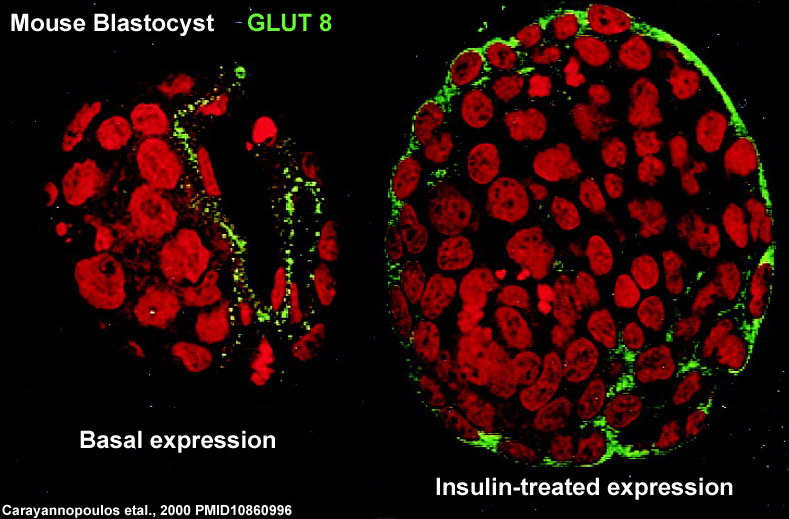File:Mouse- blastocyst GLUT8 expression.jpg
Mouse-_blastocyst_GLUT8_expression.jpg (789 × 519 pixels, file size: 94 KB, MIME type: image/jpeg)
Mouse Blastocyst GLUT8 Basal and Insulin-Stimulated Expression Expression
Confocal immunofluorescent labeling to localize GLUT8 protein expression in the blastocyst under basal and insulin-stimulated conditions.
Blastocyst under basal conditions stained with peptide-purified polyclonal antibody to the C terminus of GLUT8 (green) and propidium iodide (red) as a nuclear stain. This technique localizes the protein to the trophectoderm and primitive endoderm lining the blastocoel. Higher magnification of the trophectoderm revealing GLUT8 in vesicle-like intracellular compartment.
Blastocyst under insulin-stimulated conditions stained with the same GLUT8 antibody. This technique demonstrates a general cellular redistribution of the protein with increased plasma membrane staining. Higher magnification of the blastocyst cells revealing cytoplasmic and plasma membrane staining and less staining of the vesicle-like compartments.
Original file name: Figure 4 http://www.pnas.org/content/97/13/7313/F4.large.jpg (original full figure cropped, relabeled and size adjusted)
Reference
<pubmed>10860996</pubmed>| PMC16542 | Proc Natl Acad Sci U S A.
Abstract
Mammalian preimplantation blastocysts exhibit insulin-stimulated glucose uptake despite the absence of the only known insulin-regulated transporter, GLUT4. We describe a previously unidentified member of the mammalian facilitative GLUT superfamily that exhibits approximately 20-25% identity with other murine facilitative GLUTs. Insulin induces a change in the intracellular localization of this protein, which translates into increased glucose uptake into the blastocyst, a process that is inhibited by antisense oligoprobes. Presence of this transporter may be necessary for successful blastocyst development, fuel metabolism, and subsequent implantation. Moreover, the existence of an alternative transporter may explain examples in other tissues of insulin-regulated glucose transport in the absence of GLUT4.
- GLUT8 is a glucose transporter responsible for insulin-stimulated glucose uptake in the blastocyst.
- mammalian development when embryonic fuel metabolism switches from the oxidation of lactate and pyruvate via the Krebs cycle and oxidative phosphorylation to anaerobic metabolism of glucose via glycolysis.
- This critical substrate change is thought to be due to the biosynthetic and developmental demands placed on the embryo as the blastocyst creates the fluid-filled blastocoel and prepares for implantation.
Copyright
Proceedings National Academy of Sciences (PNAS) Liberalization of PNAS copyright policy: Noncommercial use freely allowed Note original Author should be contacted for permission to reuse for Educational purposes. See also PNAS Author Rights and Permission FAQs
- Cozzarelli NR, Fulton KR, Sullenberger DM. Liberalization of PNAS copyright policy: noncommercial use freely allowed. Proc Natl Acad Sci U S A. 2004 Aug 24;101(34):12399. PMID15314225 "Our guiding principle is that, while PNAS retains copyright, anyone can make noncommercial use of work in PNAS without asking our permission, provided that the original source is cited."
File history
Click on a date/time to view the file as it appeared at that time.
| Date/Time | Thumbnail | Dimensions | User | Comment | |
|---|---|---|---|---|---|
| current | 09:14, 3 December 2010 |  | 789 × 519 (94 KB) | S8600021 (talk | contribs) | ==Mouse Blastocyst GLUT8 Basal and Insulin-Stimulated Expression Expression== Confocal immunofluorescent labeling to localize GLUT8 protein expression in the blastocyst under basal and insulin-stimulated conditions. Blastocyst under basal conditions st |
You cannot overwrite this file.
File usage
The following page uses this file:
